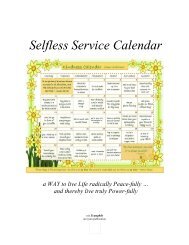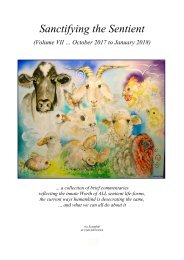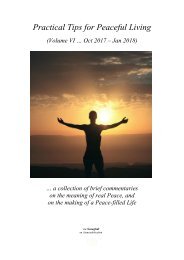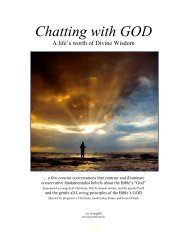Jesus Christ - a most Holy Heretic
An illuminating (and biblically exhaustive) examination of the little-known truth that Jesus Christ was not so much a supporter of the Old Testament laws of his day as he was a radically thorough reformer thereof
An illuminating (and biblically exhaustive) examination of the little-known truth that Jesus Christ was not so much a supporter of the Old Testament laws of his day as he was a radically thorough reformer thereof
You also want an ePaper? Increase the reach of your titles
YUMPU automatically turns print PDFs into web optimized ePapers that Google loves.
The triumphant entry into Jerusalem<br />
We find our next episode of importance – <strong>Jesus</strong>' “triumphant entry” into Jerusalem – near the end<br />
of the Gospel of Matthew's recounting of his ministry (see Matthew 21:1-11 – also Mark 11:1-11, Luke<br />
19:28-44, & John 12:12-19) 44 . In this story, <strong>Jesus</strong> and his disciples – having left Jericho behind 45 – were<br />
nearing the great city of Jerusalem when <strong>Jesus</strong> had them pause outside of Bethphage, a small town<br />
located at the eastern base of the Mount of Olives. Shortly thereafter <strong>Jesus</strong> sent two of his disciples<br />
into the town to procure a donkey and its young colt 46 and bring them back to him. The two disciples<br />
did as they were told and brought back<br />
the two animals, whereupon <strong>Jesus</strong> sat<br />
upon them both and rode them to<br />
Jerusalem. As he and his disciples (along<br />
with those who had followed them from<br />
Bethany – see John 12:17) went along, a<br />
“large crowd” of people spread their<br />
cloaks and “branches from the trees”<br />
(probably palm fronds, see John 12:13) on<br />
the ground before him while others<br />
announced his arrival, shouting “Hosanna<br />
to the Son of David! Blessed is the one<br />
who comes in the name of the Lord!”<br />
(Matthew 21:9 – see also Mark 11:9-10, Luke<br />
19:37-38, & John 12:12-13). Such was the<br />
spectacle that the city was “in turmoil” as<br />
he entered, with many asking “Who is<br />
this man?” and with many in the crowd<br />
answering, “This is <strong>Jesus</strong>, the prophet<br />
from Nazareth.” (see Matthew 21:10-11)<br />
44 While this is indeed one of the rare facets of <strong>Jesus</strong>' ministry that is relayed by all four canonical Gospels, there are some<br />
significant differences among the four accountings. Mark (in all likelihood the first Gospel written and thus in all<br />
likelihood the Gospel <strong>most</strong> in alignment with what many call “the Word of God”) mentions “leafy branches from the<br />
fields” – not the palm fronds mentioned indirectly by Matthew, directly by John, and not at all by Luke. In addition,<br />
unlike the other three tellings, Mark makes no mention of Zechariah 9:9's “prophecy” related to the Messiah riding into<br />
Jerusalem on a donkey. Also, unlike Matthew, the other three Gospels mention only a donkey being ridden, not a<br />
donkey and a colt, and the Synoptic Gospels all have said donkey being retrieved by <strong>Jesus</strong>' disciples, not found and<br />
“borrowed” by <strong>Jesus</strong> himself (as told in John). Finally, whereas Matthew has <strong>Jesus</strong> immediately heading into the<br />
Temple after his “triumphal entry” (to raise a ruckus with the money-changers there), Mark has him retreating back to<br />
Bethany (and spending the night there before returning to enter the Temple the next morning), Luke has him first<br />
pausing to lament the imminent suffering that will come to Jerusalem's inhabitants, and John has <strong>Jesus</strong> first telling his<br />
disciples about his imminent crucifixion and then hiding out from his would be attackers until the Last Supper.<br />
45 Interestingly, this tale has <strong>Jesus</strong> and his cohorts traveling along the same road mentioned in his Parable of The Good<br />
Samaritan (as shared in Luke 10:29-37).<br />
46 While true to Matthew's telling of the tale, in all probability only one animal was retrieved (as is indeed the case in all<br />
three of the other Gospel accounts). After all, it will forever remain unclear how anyone – even a divinely inspired<br />
Messiah – could ever manage to ride both a donkey and a much smaller colt simultaneously. Of course, this conundrum<br />
is explained easily enough as a probable mis-relaying of the Old Testament passage it intentionally recalls – that being<br />
Zechariah 9:9, which prophetically tells of a king who would arrive “humbly, riding on a donkey; even on a colt, the<br />
foal of a donkey.” This explanation gains even more credence when the reader realizes that the author of Matthew took<br />
other liberties with Zechariah 9:9 as well – attaching a portion of Isaiah 62:11 as its new introduction (“Tell the daughter<br />
of Zion”) and completely omitting the phrase “triumphant and victorious is he.”<br />
32

















